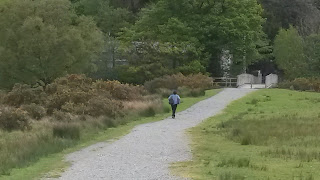A JAMAICAN CHILDHOOD - HILLSIDE REMEMBERED
S
|
haka's home was located on a small recessed plot of land on the side of a hilly terrain, with another family of 4 living in a house on another smaller recessed plot above them, followed by yet another family, and, beyond which you would end up in the uninhabited hills over-looking the village. Just above the property of the family of 4, which included a married couple and their two children, was a road which led back to the main road leading into the village, and which bypassed the home of Shaka’s family’s best family friends, the Davies. This family was comprised of the mother and 3 children, Ed, W, and El two boys and a girl. The older son, Ed, used to go shooting in the hills around the village. Ed was several years older than Shaka, and Shaka remembered him as being a kind, thoughtful and generous person. This was fully reflected in the understandable way in which Ed dealt with a notable incident involving him, Shaka, having stolen Ed's flour and cornmeal.
L
|
ooking forward, the property was separated from a very large private estate, Spring, by another much smaller river or, more accurately described, a stream, Ganga Gulley, which would also rise considerably, when it rained heavily. This stream formed the eastern boundary of the family’s home, and emptied itself into the Johnson River about half a mile downstream, bypassing Poppy’s , Mrs Brook’s, Miss Mary’s, Mass Eli and other villagers’ properties on the right, as it flows into the Johnson River, at the eastern tip of Spring on the left.
T
|
his stream did not have an abundance of fish and ganga (shrimp) but, on occasions Shaka, on his own, or with his younger brother, would go searching to see if they could find any. In the relevant fruit seasons, they would also traverse the stream, climbing the rocks and hills rising from either side of the ascending river upstream, in search of mangoes, rose apples, star apples, yams papayas, or simply to swim. The water from this stream was also used for cooking, drinking, washing and bathing.
S
|
pring was, as you might have already guessed, was owned by a wealthy family, and seemed to have had a slave history. It was where Shaka would make the 2-3 miles return journey to, early in the mornings buy fresh milk before he set off to school. As well as its cattle and horses, the estate had many coconut trees, cashew trees, mango trees, pastures, some sugar cane fields, and little ponds with gold fish and tadpoles. Shaka and some of his friends would, at times, go searching for mangoes and cashew on the estate; hoping not to be caught by any members of the Busha’s family or workers. He would also at times tie his goats in the estate’s luscious grass fields, or the less accessible tall grass verges bordering the estate. If Shaka or others wanted to visit the village of Whitehall, which was several miles north east of Hillside, they would walk through Spring Estate.
T
|
he land on which Shaka’s family lived had a variety of fruit trees and ground provisions. These included several orange trees, grapefruit trees, a couple of Pimento trees, several naseberry (Sapodilla) trees, civil or sour orange trees, a star apple tree, banana plants, cotton tree, mango trees, including a bam bay and sweetie mango trees, a dum tree, an almond tree in the centre of the yard, coconut trees, coffee trees, cocoa trees, breadfruit tree, pineapple plants, a trumpet tree (Cecropia peltata) and ackee trees. Shaka recalled that, during the planting season, the family would plant sweet potatoes, jam, pumpking, cho cho, cassava,gungo peas, and butter beans.
S
|
haka remembered how he was always amazed to watch seeds he had planted burst forth from the soil. Such as how a pumpkin seed pushed itself out of the soil, adorned first with two little leaves, and then, in the course of time, snaked its way along the ground, taking root as it does so, before bursting into yellow flowers which would soon be followed by young pumpkins. How a similar path would be followed by the sweet potato plants, which, like the pumpkins, would turn the land they grow on, verdant. Shaka also remembered how when he planted his first pudding cho cho, near to the sawa sop tree, it also grew up and snaked its way around the sawa sop tree, and, in time, blossomed into its white flowers, before starting to bear many cho chos
W
|
atching plants fruiting trees and plant blossoming, and young fruits, such as mangoes, star apples, oranges, acke, pears, tambrins, cashew, jackfruit, etc, starting to develop were exciting times which were full of expectation for Shaka. In the first instance, he used to find the different flowering trees fascinating and beautiful, and in the second, he looked forward to when the fruits would be ripe and he would relish picking them, selling and eating them. This is a reflection of the physical setting in which Shaka spent his childhood, upto the age of 15, with the occasional trips to other parts of the Island, such as to visit his maternal grandmother and relatives in Manchester, maternal aunts in Kingston, the capital of the Jamaica, and school trips to the National Stadium and the Jamaica Gleaner company.
OWOHROD
OWOHROD








Comments